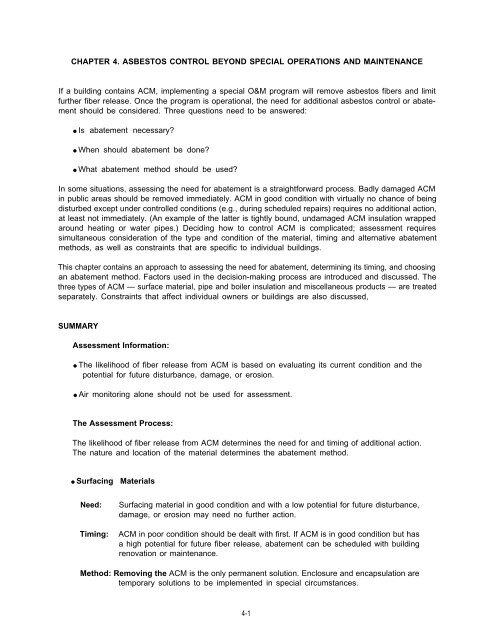EPA 560/5-85-024 Guidance for Controlling Asbestos-Containing ...
EPA 560/5-85-024 Guidance for Controlling Asbestos-Containing ...
EPA 560/5-85-024 Guidance for Controlling Asbestos-Containing ...
Create successful ePaper yourself
Turn your PDF publications into a flip-book with our unique Google optimized e-Paper software.
CHAPTER 4. ASBESTOS CONTROL BEYOND SPECIAL OPERATIONS AND MAINTENANCE<br />
If a building contains ACM, implementing a special O&M program will remove asbestos fibers and limit<br />
further fiber release. Once the program is operational, the need <strong>for</strong> additional asbestos control or abatement<br />
should be considered. Three questions need to be answered:<br />
● Is abatement necessary?<br />
● When should abatement be done?<br />
● What abatement method should be used?<br />
In some situations, assessing the need <strong>for</strong> abatement is a straight<strong>for</strong>ward process. Badly damaged ACM<br />
in public areas should be removed immediately. ACM in good condition with virtually no chance of being<br />
disturbed except under controlled conditions (e.g., during scheduled repairs) requires no additional action,<br />
at least not immediately. (An example of the latter is tightly bound, undamaged ACM insulation wrapped<br />
around heating or water pipes.) Deciding how to control ACM is complicated; assessment requires<br />
simultaneous consideration of the type and condition of the material, timing and alternative abatement<br />
methods, as well as constraints that are specific to individual buildings.<br />
This chapter contains an approach to assessing the need <strong>for</strong> abatement, determining its timing, and choosing<br />
an abatement method. Factors used in the decision-making process are introduced and discussed. The<br />
three types of ACM — surface material, pipe and boiler insulation and miscellaneous products — are treated<br />
separately. Constraints that affect individual owners or buildings are also discussed,<br />
SUMMARY<br />
Assessment In<strong>for</strong>mation:<br />
● The likelihood of fiber release from ACM is based on evaluating its current condition and the<br />
potential <strong>for</strong> future disturbance, damage, or erosion.<br />
● Air monitoring alone should not be used <strong>for</strong> assessment.<br />
The Assessment Process:<br />
The likelihood of fiber release from ACM determines the need <strong>for</strong> and timing of additional action.<br />
The nature and location of the material determines the abatement method.<br />
● Surfacing Materials<br />
Need: Surfacing material in good condition and with a low potential <strong>for</strong> future disturbance,<br />
damage, or erosion may need no further action.<br />
Timing: ACM in poor condition should be dealt with first. If ACM is in good condition but has<br />
a high potential <strong>for</strong> future fiber release, abatement can be scheduled with building<br />
renovation or maintenance.<br />
Method: Removing the ACM is the only permanent solution. Enclosure and encapsulation are<br />
temporary solutions to be implemented in special circumstances.<br />
4-1

















